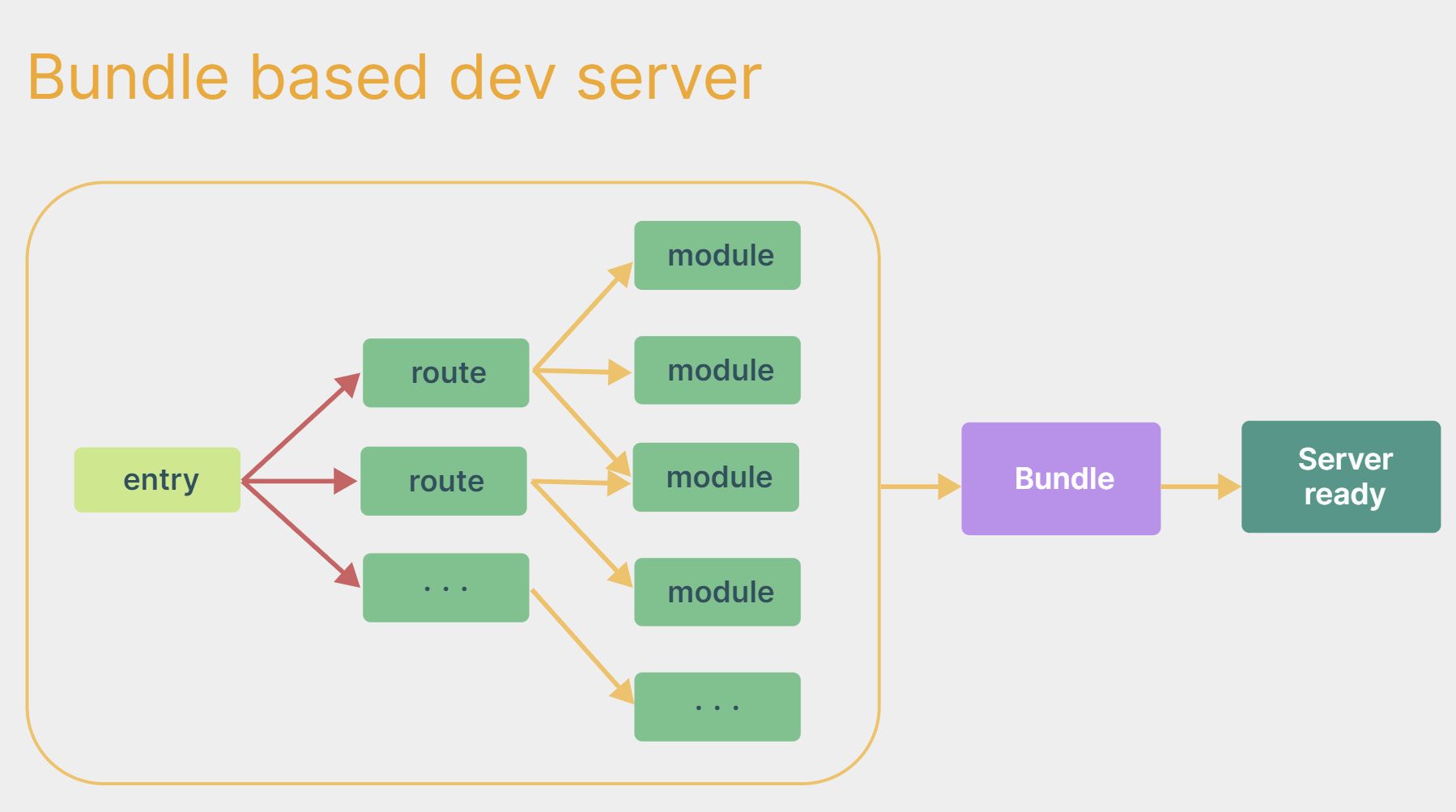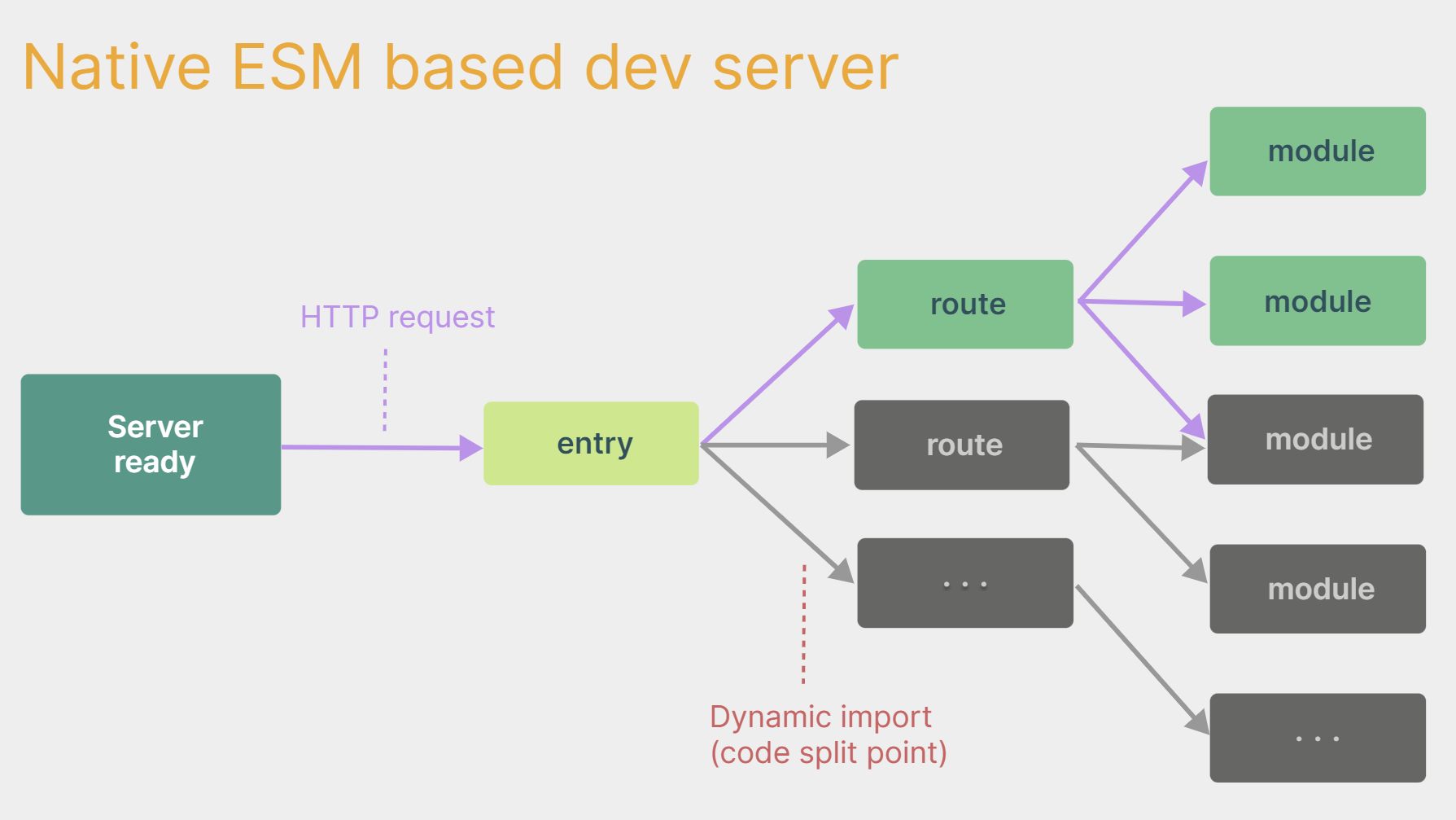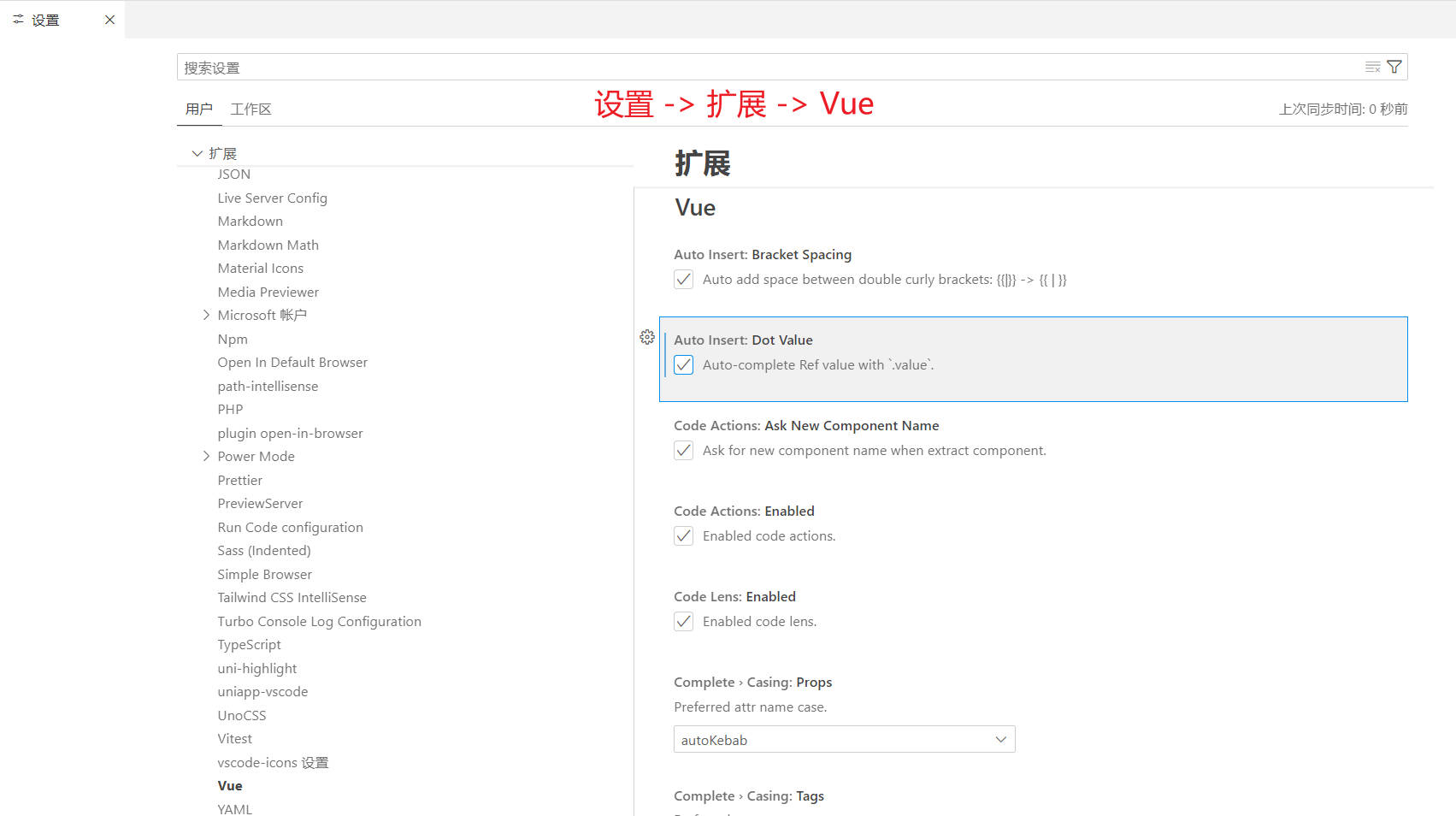# 参考
https://cn.vuejs.org/
https://www.bilibili.com/video/BV1Za4y1r7KE
# 编码规范
在 Vue3 中
- 编程语言:JavaScript、TypeScript
- 代码风格:组合式 API、选项式 API
- 简写形式:setup 语法糖
# 介绍
🐈︎ 官方发版地址
- 性能提升
- 源码升级
- 使用
Proxy代替defineProperty实现响应式 - 重写虚拟
DOM的实现和Tree-Shaking
- 使用
- 拥抱 TypeScript
新的特性:
Composition API(组合 API):
setup
ref 与 reactive
computed 与 watch
...
新的内置组件:
Fragment
Teleport
Suspense
...
其他改变:
新的生命周期钩子
data 选项应始终被声明为一个函数
移除 keyCode 支持作为 v-on 的修饰符
...
# 创建项目
# vue-cli
📑 官方文档
# 查看 @vue/cli 版本,确保 @vue/cli 版本在 4.5.0 以上 | |
vue --version | |
# 安装或者升级你的 @vue/cli | |
npm install -g @vue/cli | |
# 执行创建命令 | |
vue create vue_test | |
# 随后选择 3.x | |
# Choose a version of Vue.js that you want to start the project with (Use arrow keys) | |
# > 3.x | |
# 2.x | |
# 启动 | |
cd vue_test | |
npm run serve |
# vite
📑 官方文档
新一代前端构建工具,官网地址:https://vitejs.cn
优势:
轻量快速的热重载(HMR),能实现极速的服务启动
对 TypeScript、JSX、CSS 等支持开箱即用
真正的按需编译,不再等待整个应用编译完成
webpack 构建 与 vite 构建对比图如下:
![1683167182037-71c78210-8217-4e7d-9a83-e463035efbbe]()
![1683167204081-582dc237-72bc-499e-9589-2cdfd452e62f]()
# 创建命令 | |
npm create vue@latest | |
# 具体配置 | |
√ Project name: vue3_test # 配置项目名称 | |
√ Add TypeScript? Yes # 是否添加 TypeScript 支持 | |
√ Add JSX Support? No # 是否添加 JSX 支持 | |
√ Add Vue Router for Single Page Application development? No # 是否添加路由环境 | |
√ Add Pinia for state management? No # 是否添加 pinia 环境 | |
√ Add Vitest for Unit Testing? No # 是否添加单元测试 | |
√ Add an End-to-End Testing Solution? » No # 是否添加端到端测试方案 | |
√ Add ESLint for code quality? Yes # 是否添加 ESLint 语法检查 | |
√ Add Prettier for code formatting? No # 是否添加 Prettiert 代码格式化 |
- Vite 项目中,
index.html是项目的入口文件,在项目最外层 - 加载
index.html后,Vite 解析<script type="module" src="xxx">指向的JavaScript - Vue3 中是通过
createApp函数创建一个应用实例
# 语法 👇🏻
# OptionsAPI 与 CompositionAPI
- Vue2 的 API 设计是 Options(配置)风格的
- Vue3 的 API 设计是 Composition(组合)风格的
# Options API 的弊端
Options 类型的 API,数据、方法、计算属性等,是分散在: data 、 methods 、 computed 中的
若想新增或者修改一个需求,就需要分别修改: data 、 methods 、 computed ,不便于维护和复用

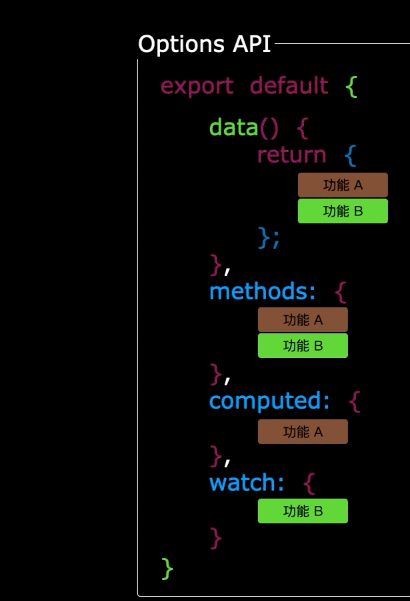
# Composition API 的优势
可以用函数的方式,更加优雅的组织代码,让相关功能的代码更加有序的组织在一起

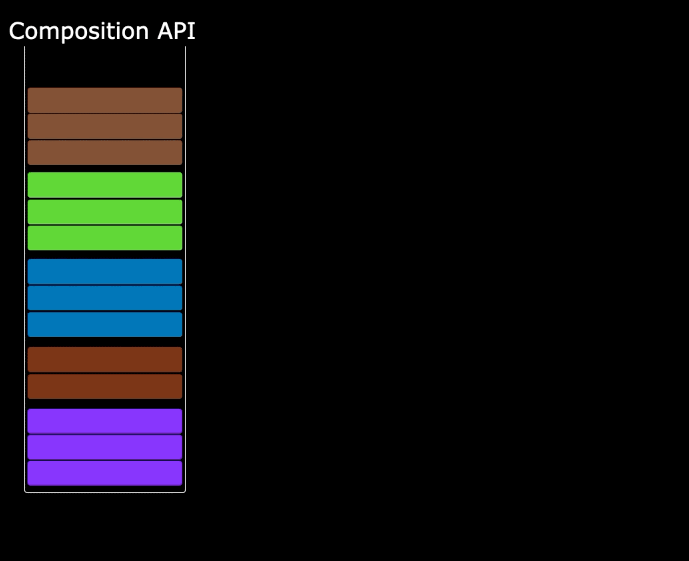
# setup
# 概述
Vue3 中一个新的配置项,值是一个函数,它是 Composition API “表演的舞台”,组件中所用到的:数据、方法、计算属性、监视...... 等等,均配置在 setup 中
特点:
- setup 函数返回的对象中的内容,可直接在模板中使用
- setup 访问 this 是
undefined - setup 函数会在
beforeCreate之前调用,它是 “领先” 所有钩子执行的
<template> | |
<h2>姓名:</h2> | |
<button @click="changeName">修改名字</button> | |
</template> | |
<script lang="ts"> | |
export default { | |
name: "Person", | |
setup() { | |
// 原来写在 data 中(注意:此时的 name 不是响应式数据) | |
let name = "张三"; | |
function changeName() { | |
name = "李四"; | |
console.log(name); | |
} | |
// 返回一个对象,对象中的内容,模板中可以直接使用 | |
return { name, changeName }; | |
} | |
}; | |
</script> |
# setup 的返回值
若返回一个对象:则对象中的:属性、方法等,在模板中均可以直接使用 **(重点关注)**
若返回一个函数:则可以自定义渲染内容,代码如下:
setup() {
return () => '你好啊!'
}
# 与 Options API 的关系
- Vue2 的配置(data、methods ......)中可以访问到 setup 中的属性、方法
- 但在 setup 中不能访问到 Vue2 的配置(data、methods ......)
- 如果与 Vue2 冲突,则 setup 优先
# setup 语法糖
可以把 setup 独立出去
<template> | |
<h2>姓名:</h2> | |
<button @click="changeName">修改名字</button> | |
</template> | |
<script lang="ts"> | |
export default { | |
name: "Person" | |
}; | |
</script> | |
<script setup lang="ts"> | |
let name = "张三"; | |
function changName() { | |
name = "李四"; // 注意:此时这么修改 name 页面是不变化的 | |
} | |
</script> |
借助 vite 中的插件简化,去指定组件名字
# 安装插件 | |
npm i vite-plugin-vue-setup-extend -D |
修改 vite.config.ts 文件
import { defineConfig } from "vite"; | |
import VueSetupExtend from "vite-plugin-vue-setup-extend"; | |
export default defineConfig({ | |
plugins: [VueSetupExtend()] | |
}); |
此时代码可简化为:
<script setup lang="ts" name="Person"></script> |
# 响应式数据
# ref:基本类型的响应式数据
- 作用:定义响应式变量
- 语法:
let xxx = ref(初始值) - 返回值:一个
RefImpl的实例对象,简称 ref 对象 或 ref,ref 对象的 value 属性是响应式的 - 注意点:
- JS 中操作数据需要:
xxx.value,但模板中不需要.value,直接使用即可 - 对于
let name = ref('张三')来说,name不是响应式的,name.value是响应式的
- JS 中操作数据需要:
<template> | |
<h2>姓名:</h2> | |
<button @click="changeName">修改名字</button> | |
</template> | |
<script setup lang="ts" name="Person"> | |
import { ref } from "vue"; | |
//name 是一个 RefImpl 的实例对象,简称 ref 对象,它们的 value 属性是响应式的 | |
let name = ref("张三"); | |
function changeName() { | |
// JS 中操作 ref 对象时候需要.value | |
name.value = "李四"; | |
console.log(name.value); | |
} | |
</script> |
# reactive:对象类型的响应式数据
- 作用:定义一个响应式对象(基本类型不要用它,要用
ref,否则报错) - 语法:
let 响应式对象= reactive(源对象) - 返回值:一个
Proxy的实例对象,简称:响应式对象 - 注意点:reactive 定义的响应式数据是 “深层次” 的
<template> | |
<h2>游戏列表:</h2> | |
<ul> | |
<li v-for="g in games" :key="g.id"></li> | |
</ul> | |
<button @click="changeFirstGame">修改游戏</button> | |
</template> | |
<script lang="ts" setup name="Person"> | |
import { reactive } from "vue"; | |
let games = reactive([ | |
{ id: 1, name: "开心消消乐" }, | |
{ id: 2, name: "王者荣耀" }, | |
{ id: 3, name: "蛋仔派对" } | |
]); | |
function changeFirstGame() { | |
games[0].name = "英雄联盟"; | |
} | |
</script> |
# ref:对象类型的响应式数据
- 其实 ref 接收的数据可以是:基本类型、对象类型
- 若 ref 接收的是对象类型,内部其实也是调用了 reactive 函数
<template> | |
<h2>游戏列表:</h2> | |
<ul> | |
<li v-for="g in games" :key="g.id"></li> | |
</ul> | |
<button @click="changeFirstGame">修改游戏</button> | |
</template> | |
<script lang="ts" setup name="Person"> | |
import { ref } from "vue"; | |
let games = ref([ | |
{ id: 1, name: "开心消消乐" }, | |
{ id: 2, name: "王者荣耀" }, | |
{ id: 3, name: "蛋仔派对" } | |
]); | |
function changeFirstGame() { | |
games.value[0].name = "英雄联盟"; | |
} | |
</script> |
# 两者对比
宏观角度看:
- ref:定义基本类型数据、对象类型数据
- reactive:定义对象类型数据
区别:
ref 创建的变量必须使用
.value(可以使用 volar 插件自动添加.value)![Snipaste_2024-11-17_17-57-04]()
reactive 重新分配一个新对象,会失去响应式(可以使用
Object.assign去整体替换)示例
<template><h2>一辆,价值:</h2>
<button @click="changeCar">修改车信息</button>
</template><script lang="ts" setup name="Person">
import { ref, reactive } from "vue";
let car = reactive({
name: "奔驰",
price: 100000
});
function changePrice() {
car.price += 10000;
}function changeCar() {
car = { name: "宝马", price: 200000 }; // 页面不更新
car = Object.assign(car, { name: "宝马", price: 200000 });
//car.value = {name: "宝马", price: 200000} // 若此时 car 用 ref 来定义}</script>
使用原则:
- 若需要一个基本类型的响应式数据,必须使用
ref - 若需要一个响应式对象,层级不深,
ref、reactive都可以 - 若需要一个响应式对象,且层级较深,推荐使用
reactive
# toRefs 与 toRef
- 作用:将一个响应式对象中的每一个属性,转换为
ref对象(解构对象使每个属性成为响应式数据) - 备注:
toRefs与toRef功能一致,但toRefs可以批量转换
示例
<template> | |
<h2>姓名:</h2> | |
<h2>年龄:</h2> | |
<h2>性别:</h2> | |
<button @click="changeName">修改名字</button> | |
<button @click="changeAge">修改年龄</button> | |
<button @click="changeSex">修改性别</button> | |
</template> | |
<script lang="ts" setup name="Person"> | |
import { ref, reactive, toRefs, toRef } from 'vue' | |
let person = reactive({ name: '张三', age: 18, sex: '男's }) | |
// 通过 toRefs 将 person 对象中的 n 个属性批量取出,且依然保持响应式的能力 | |
let { name, sex } = toRefs(person) | |
// 通过 toRef 将 person 对象中的 sex 属性取出,且依然保持响应式的能力 | |
let age = toRef(person,'age') | |
function changeName() { | |
name.value += '~' | |
} | |
function changeAge() { | |
age.value += 1 | |
} | |
function changeSex() { | |
sex.value = '女' | |
} | |
</script> |
# computed
根据已有数据计算出新数据
+++sucess 示例
<template> | |
<div> | |
姓:<input type="text" v-model="firstName" /> <br /> | |
名:<input type="text" v-model="lastName" /> <br /> | |
全名:<span></span> <br /> | |
<button @click="changeFullName">全名改为:li-si</button> | |
</div> | |
</template> | |
<script setup lang="ts" name="App"> | |
import { ref, computed } from "vue"; | |
let firstName = ref("zhang"); | |
let lastName = ref("san"); | |
// 只读取,不修改 | |
// let fullName = computed(() => { | |
// return firstName.value + "-" + lastName.value; | |
// }); | |
// 可读可写 | |
let fullName = computed({ | |
// 读取 | |
get() { | |
return firstName.value + "-" + lastName.value; | |
}, | |
// 修改 | |
set(val) { | |
firstName.value = val.split("-")[0]; | |
lastName.value = val.split("-")[1]; | |
} | |
}); | |
function changeFullName() { | |
fullName.value = "li-si"; | |
} | |
</script> |
+++
# watch
- 作用:监视数据的变化
- 特点:Vue3 中的 watch 只能监视以下四种数据:
- ref 定义的数据
- reactive 定义的数据
- 函数返回一个值(getter 函数)
- 一个包含上述内容的数组
# 情况一
监视 ref 定义的【基本类型】数据:直接写数据名即可,监视的是其 value 值的改变
示例
<template> | |
<h1>情况一:监视【ref】定义的【基本类型】数据</h1> | |
<h2>当前求和为:</h2> | |
<button @click="changeSum">点我sum+1</button> | |
</template> | |
<script lang="ts" setup name="Person"> | |
import { ref, watch } from "vue"; | |
let sum = ref(0); | |
function changeSum() { | |
sum.value += 1; | |
} | |
const stopWatch = watch(sum, (newValue, oldValue) => { | |
console.log("sum变化了", newValue, oldValue); | |
if (newValue >= 10) { | |
stopWatch(); | |
} | |
}); | |
</script> |
# 情况二
监视 ref 定义的【对象类型】数据:直接写数据名,监视的是对象的【地址值】
若想监视对象内部的数据,要手动开启深度监视
⚠️ 注:
若修改的是 ref 定义的对象中的属性:newValue 和 oldValue 都是新值,因为它们是同一个对象
若修改整个 ref 定义的对象:newValue 是新值, oldValue 是旧值,因为不是同一个对象了
示例
<template> | |
<h1>情况二:监视【ref】定义的【对象类型】数据</h1> | |
<h2>姓名:</h2> | |
<h2>年龄:</h2> | |
<button @click="changeName">修改名字</button> | |
<button @click="changeAge">修改年龄</button> | |
<button @click="changePerson">修改整个人</button> | |
</template> | |
<script lang="ts" setup name="Person"> | |
import { ref, watch } from "vue"; | |
let person = ref({ | |
name: "张三", | |
age: 18 | |
}); | |
function changeName() { | |
person.value.name += "~"; | |
} | |
function changeAge() { | |
person.value.age += 1; | |
} | |
function changePerson() { | |
person.value = { name: "李四", age: 90 }; | |
} | |
/* | |
情况 1:监视的是对象的地址值,若想监视对象内部属性的变化,需要手动开启深度监视 | |
第一个参数:被监视的数据 | |
第二个参数:监视的回调 | |
第三个参数:配置对象(deep、immediate 等等...) | |
watch (person, (newValue, oldValue) => { | |
console.log ("person 变化了", newValue, oldValue) | |
}) | |
*/ | |
// 情况 2:深度监视 | |
watch( | |
person, | |
(newValue, oldValue) => { | |
console.log("person变化了", newValue, oldValue); | |
}, | |
{ deep: true } | |
); | |
</script> |
# 情况三
监视 reactive 定义的【对象类型】数据,且默认开启了深度监视
示例
<template> | |
<h1>情况三:监视【reactive】定义的【对象类型】数据</h1> | |
<h2>姓名:</h2> | |
<h2>年龄:</h2> | |
<button @click="changeName">修改名字</button> | |
<button @click="changeAge">修改年龄</button> | |
<button @click="changePerson">修改整个人</button> | |
<hr /> | |
<h2>测试:</h2> | |
<button @click="test">修改obj.a.b.c</button> | |
</template> | |
<script lang="ts" setup name="Person"> | |
import { reactive, watch } from "vue"; | |
let person = reactive({ | |
name: "张三", | |
age: 18 | |
}); | |
let obj = reactive({ | |
a: { | |
b: { | |
c: 666 | |
} | |
} | |
}); | |
function changeName() { | |
person.name += "~"; | |
} | |
function changeAge() { | |
person.age += 1; | |
} | |
function changePerson() { | |
Object.assign(person, { name: "李四", age: 80 }); | |
} | |
function test() { | |
obj.a.b.c = 888; | |
} | |
// 默认是开启深度监视的 | |
watch(person, (newValue, oldValue) => { | |
console.log("person变化了", newValue, oldValue); | |
}); | |
watch(obj, (newValue, oldValue) => { | |
console.log("Obj变化了", newValue, oldValue); | |
}); | |
</script> |
# 情况四
监视 ref 或 reactive 定义的【对象类型】数据中的某个属性,注意点如下:
- 若该属性值不是【对象类型】,需要写成函数形式
- 若该属性值是依然是【对象类型】,可直接编,也可写成函数,建议写成函数
结论:监视的要是对象里的属性,那么最好写函数式,注意点:若是对象监视的是地址值,需要关注对象内部,需要手动开启深度监视
示例
<template> | |
<h1>情况四:监视【ref】或【reactive】定义的【对象类型】数据中的某个属性</h1> | |
<h2>姓名:</h2> | |
<h2>年龄:</h2> | |
<h2>汽车:、</h2> | |
<button @click="changeName">修改名字</button> | |
<button @click="changeAge">修改年龄</button> | |
<button @click="changeC1">修改第一台车</button> | |
<button @click="changeC2">修改第二台车</button> | |
<button @click="changeCar">修改整个车</button> | |
</template> | |
<script lang="ts" setup name="Person"> | |
import { reactive, watch } from "vue"; | |
let person = reactive({ | |
name: "张三", | |
age: 18, | |
car: { | |
c1: "奔驰", | |
c2: "宝马" | |
} | |
}); | |
function changeName() { | |
person.name += "~"; | |
} | |
function changeAge() { | |
person.age += 1; | |
} | |
function changeC1() { | |
person.car.c1 = "奥迪"; | |
} | |
function changeC2() { | |
person.car.c2 = "大众"; | |
} | |
function changeCar() { | |
person.car = { c1: "雅迪", c2: "爱玛" }; | |
} | |
// 监视响应式对象中的某个属性,且该属性是基本类型的,要写成函数式 | |
/* | |
watch (()=> person.name,(newValue,oldValue) => { | |
console.log ('person.name 变化了 ',newValue,oldValue) | |
}) | |
*/ | |
// 监视响应式对象中的某个属性,且该属性是对象类型的,可以直接写,也能写函数,更推荐写函数 | |
watch( | |
() => person.car, | |
(newValue, oldValue) => { | |
console.log("person.car变化了", newValue, oldValue); | |
}, | |
{ deep: true } | |
); | |
</script> |
# 情况五
监视上述的多个数据
示例
<template> | |
<h1>情况五:监视上述的多个数据</h1> | |
<h2>姓名:</h2> | |
<h2>年龄:</h2> | |
<h2>汽车:、</h2> | |
<button @click="changeName">修改名字</button> | |
<button @click="changeAge">修改年龄</button> | |
<button @click="changeC1">修改第一台车</button> | |
<button @click="changeC2">修改第二台车</button> | |
<button @click="changeCar">修改整个车</button> | |
</template> | |
<script lang="ts" setup name="Person"> | |
import { reactive, watch } from "vue"; | |
let person = reactive({ | |
name: "张三", | |
age: 18, | |
car: { | |
c1: "奔驰", | |
c2: "宝马" | |
} | |
}); | |
function changeName() { | |
person.name += "~"; | |
} | |
function changeAge() { | |
person.age += 1; | |
} | |
function changeC1() { | |
person.car.c1 = "奥迪"; | |
} | |
function changeC2() { | |
person.car.c2 = "大众"; | |
} | |
function changeCar() { | |
person.car = { c1: "雅迪", c2: "爱玛" }; | |
} | |
watch( | |
[() => person.name, person.car], | |
(newValue, oldValue) => { | |
console.log("person.car变化了", newValue, oldValue); | |
}, | |
{ deep: true } | |
); | |
</script> |
# watchEffect
立即运行一个函数,同时响应式地追踪其依赖,并在依赖更改时重新执行该函数
watch 对比 watchEffect
都能监听响应式数据的变化,不同的是监听数据变化的方式不同
watch:要明确指出监视的数据
watchEffect:不用明确指出监视的数据(函数中用到哪些属性,那就监视哪些属性)
示例
<template> | |
<h1>需求:水温达到50℃,或水位达到20cm,则联系服务器</h1> | |
<h2 id="demo">水温:</h2> | |
<h2>水位:</h2> | |
<button @click="changePrice">水温+1</button> | |
<button @click="changeSum">水位+10</button> | |
</template> | |
<script lang="ts" setup name="Person"> | |
import { ref, watch, watchEffect } from "vue"; | |
let temp = ref(0); | |
let height = ref(0); | |
function changePrice() { | |
temp.value += 10; | |
} | |
function changeSum() { | |
height.value += 1; | |
} | |
//watch:需要明确指出要监视的数据 | |
watch([temp, height], value => { | |
const [newTemp, newHeight] = value; // 从 value 中获取最新的 temp 值、height 值 | |
if (newTemp >= 50 || newHeight >= 20) { | |
console.log("联系服务器"); | |
} | |
}); | |
//watchEffect:不用 | |
const stopWatch = watchEffect(() => { | |
if (temp.value >= 50 || height.value >= 20) { | |
console.log(document.getElementById("demo")?.innerText); | |
console.log("联系服务器"); | |
} | |
// 水温达到 100,或水位达到 50,取消监视 | |
if (temp.value === 100 || height.value === 50) { | |
console.log("清理了"); | |
stopWatch(); | |
} | |
}); | |
</script> |
# 标签的 ref 属性
用于注册模板引用
用在普通 DOM 标签上,获取的是 DOM 节点
用在组件标签上,获取的是组件实例对象
示例:普通 DOM 标签
<template> | |
<h1 ref="title1">尚硅谷</h1> | |
<h2 ref="title2">前端</h2> | |
<h3 ref="title3">Vue</h3> | |
<button @click="showLog">点我打印元素</button> | |
</template> | |
<script lang="ts" setup name="Person"> | |
import { ref } from "vue"; | |
let title1 = ref(); | |
let title2 = ref(); | |
let title3 = ref(); | |
function showLog() { | |
// 通过 id 获取元素 | |
const t1 = document.getElementById("title1"); | |
console.log((t1 as HTMLElement).innerText); | |
console.log((<HTMLElement>t1).innerText); | |
console.log(t1?.innerText); | |
// 通过 ref 获取元素 | |
console.log(title1.value); | |
console.log(title2.value); | |
console.log(title3.value); | |
} | |
</script> |
示例:组件标签
<!-- 父组件 App.vue --> | |
<template> | |
<Person ref="ren" /> | |
<button @click="test">测试</button> | |
</template> | |
<script lang="ts" setup name="App"> | |
import Person from "./components/Person.vue"; | |
import { ref } from "vue"; | |
let ren = ref(); | |
function test() { | |
console.log(ren.value.name); | |
console.log(ren.value.age); | |
} | |
</script> | |
<!-- 子组件 Person.vue 中要使用 defineExpose 暴露内容 --> | |
<script lang="ts" setup name="Person"> | |
import { ref, defineExpose } from "vue"; | |
let name = ref("张三"); | |
let age = ref(18); | |
// 使用 defineExpose 将组件中的数据交给外部 | |
defineExpose({ name, age }); | |
</script> |
# props
示例
types/index.ts
// 定义接口,限制 Person 对象的格式 | |
export interface PersonInter { | |
id: string; | |
name: string; | |
age: number; | |
} | |
// 定义自定义类型 Persons | |
export type Persons = Array<PersonInter>; |
App.vue(父组件)
<template> | |
<Person :list="persons" /> | |
</template> | |
<script lang="ts" setup name="App"> | |
import Person from "./components/Person.vue"; | |
import { reactive } from "vue"; | |
import { type Persons } from "./types"; | |
let persons = reactive<Persons>([ | |
{ id: "e98219e12", name: "张三", age: 18 }, | |
{ id: "e98219e13", name: "李四", age: 19 }, | |
{ id: "e98219e14", name: "王五", age: 20 } | |
]); | |
</script> |
Person.vue(子组件)
<template> | |
<ul> | |
<li v-for="item in list" :key="item.id">--</li> | |
</ul> | |
</template> | |
<script lang="ts" setup name="Person"> | |
import { defineProps } from "vue"; | |
import { type PersonInter } from "@/types"; | |
// 写法 1:仅接收 | |
// const props = defineProps(['list']) | |
// 写法 2:接收 + 限制类型 | |
// defineProps<{list:Persons}>() | |
// 写法 3:接收 + 限制类型 + 指定默认值 + 限制必要性 | |
let props = withDefaults(defineProps<{ list?: Persons }>(), { | |
list: () => [{ id: "asdasg01", name: "呆呆", age: 18 }] | |
}); | |
console.log(props); | |
</script> |
# 生命周期
Vue 组件实例在创建时要经历一系列的初始化步骤,在此过程中 Vue 会在合适的时机,调用特定的函数,从而让开发者有机会在特定阶段运行自己的代码,这些特定的函数统称为:生命周期钩子
Vue2 的生命周期:
创建阶段:
beforeCreate、created挂载阶段:
beforeMount、mounted更新阶段:
beforeUpdate、updated销毁阶段:
beforeDestroy、destroyed
Vue3 的生命周期:
创建阶段:
setup挂载阶段:
onBeforeMount、onMounted更新阶段:
onBeforeUpdate、onUpdated卸载阶段:
onBeforeUnmount、onUnmounted
常用的钩子: onMounted (挂载完毕)、 onUpdated (更新完毕)、 onBeforeUnmount (卸载之前)
示例:生命周期
<template> | |
<h2>当前求和为:</h2> | |
<button @click="changeSum">点我sum+1</button> | |
</template> | |
<script lang="ts" setup name="Person"> | |
import { | |
ref, | |
onBeforeMount, | |
onMounted, | |
onBeforeUpdate, | |
onUpdated, | |
onBeforeUnmount, | |
onUnmounted | |
} from "vue"; | |
let sum = ref(0); | |
function changeSum() { | |
sum.value += 1; | |
} | |
console.log("setup"); | |
onBeforeMount(() => { | |
console.log("挂载之前"); | |
}); | |
onMounted(() => { | |
console.log("挂载完毕"); | |
}); | |
onBeforeUpdate(() => { | |
console.log("更新之前"); | |
}); | |
onUpdated(() => { | |
console.log("更新完毕"); | |
}); | |
onBeforeUnmount(() => { | |
console.log("卸载之前"); | |
}); | |
onUnmounted(() => { | |
console.log("卸载完毕"); | |
}); | |
</script> |
# 自定义 hook
什么是 hook?本质是一个函数,把 setup 函数中使用的
Composition API进行了封装,类似于 vue2.x 中的mixin自定义 hook 的优势:复用代码,让 setup 中的逻辑更清楚易懂
示例
useSum.ts
import { ref, onMounted } from "vue"; | |
export default function () { | |
let sum = ref(0); | |
const increment = () => { | |
sum.value += 1; | |
}; | |
const decrement = () => { | |
sum.value -= 1; | |
}; | |
onMounted(() => { | |
increment(); | |
}); | |
// 向外部暴露数据 | |
return { sum, increment, decrement }; | |
} |
useDog.ts
import { reactive, onMounted } from "vue"; | |
import axios, { AxiosError } from "axios"; | |
export default function () { | |
let dogList = reactive<string[]>([]); | |
async function getDog() { | |
try { | |
// 发请求 | |
let { data } = await axios.get( | |
"https://dog.ceo/api/breed/pembroke/images/random" | |
); | |
// 维护数据 | |
dogList.push(data.message); | |
} catch (error) { | |
// 处理错误 | |
const err = <AxiosError>error; | |
console.log(err.message); | |
} | |
} | |
onMounted(() => { | |
getDog(); | |
}); | |
// 向外部暴露数据 | |
return { dogList, getDog }; | |
} |
组件具体使用
<template> | |
<h2>当前求和为:</h2> | |
<button @click="increment">点我+1</button> | |
<button @click="decrement">点我-1</button> | |
<hr /> | |
<img | |
v-for="(u, index) in dogList.urlList" | |
:key="index" | |
:src="(u as string)" | |
/> | |
<span v-show="dogList.isLoading">加载中...</span><br /> | |
<button @click="getDog">再来一只修勾</button> | |
</template> | |
<script lang="ts"> | |
import { defineComponent } from "vue"; | |
export default defineComponent({ | |
name: "App" | |
}); | |
</script> | |
<script setup lang="ts"> | |
import useSum from "@/hooks/useSum"; | |
import useDog from "@/hooks/useDog"; | |
let { sum, increment, decrement } = useSum(); | |
let { dogList, getDog } = useDog(); | |
</script> |

